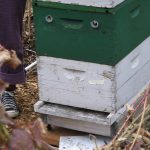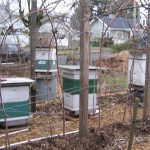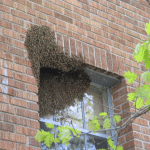
This is part two of a three part series on the beekeeping workshop I attended recently.
Reproduction:
It was interesting to learn that it is up to the female worker bees to determine when it is time to hatch a new queen bee, more worker bees, or drone bees. The worker bees are the ones who prepare the cells (areas in the comb where eggs are laid) and what the queen bee lays is based on the cell size. The queen feels with her antennas to determine if it is a big cell or small cell. If it is a big cell, she lays an unfertilized egg to become a drone. If it is a small cell, she lays a fertilized egg that will become a work bee.
The worker bees manage the population of the colony and determine when it is time to single out one cell to become the next queen bee. All female eggs have the ability to become a queen. They build the cell into a peanut shape, so it is much larger than any other cell, and they feed the larvae royal jelly to become the next queen. A queen is hatched in only 16 days, where worker bees need 21 days and drones need 24 days to hatch.
Environment:
Colonies need to stay dry, otherwise the bees get too cold and will die off. Position the hive where it will get some sun. It is ideal if the hive is situation out of strong winds. It is easiest to harvest the honey from the side of the hive. Make sure you have a good spot, as it is difficult to move the hive much further than 2′ at a time once established.
Provide water somewhere near the hive and keep fresh water available at all times. If you train them from the beginning to access this spot for water, it will make things much easier. No one wants calls from the neighbors complaining that hundreds of bees keep hanging out in their swimming pool. Keep in mind that bees are not good swimmers, so put rocks in birdbaths so they can access the water without drowning. Glen uses a moss garden to give water to his bees, which works very well.
Swarming:
It is not fully understood why colonies will swarm, but it can often be attributed to over-crowding. It is unlikely to have a colony swarm in the first year. In preparation for swarming, worker bees will keep the queen moving so she sheds some weight for the big flight, resulting in no eggs being laid.
They typically swarm within 100 feet of the colony, where they remain for anywhere from 20 minutes to two weeks. During that time, scouts are sent out in different directions to find a new, permanent home.
The bees are all less likely to sting while they are swarming because the worker bees gorged themselves before flight, not knowing when their next meal would be. A bee needs to bend it’s stinger down to sting, which is painful with a full stomach.
When capturing a swarm, Glen will cut off the branch they are swarming onto and shake into a bee box. He captures about 80% of the colony and leaves the box out overnight. The other 20% will eventually return, but they will be intercepted by the pheromones from the other colony members which alerts them to the new colony location in the box.
Another beekeeping post will go up in the next couples days to talk about starting equipment!





 This has become my
This has become my
 This is from South
This is from South


 All the ornamental grasses get cu
All the ornamental grasses get cu



Hi,
I found your site when searching for ways to keep chickens out of raised beds. I’m hoping your system will work well for me, just installed it this AM. Love your site and will be back to browse more. We have free ranging chickens, love to grow veggies, and have bees,all on a small lot in suburban MD. Happy Gardening
Welcome Sandra! Hope the bird netting works well for you tied securely over the beds. My veggies are thriving now that the chickens are kept at bay!
It works!! But how do you plan to protect taller plants such as tomatoes? Mine usually get to about 5 feet, and I can’t imagine having hoops anywhere near that height. If (when) you come up with a solution, please share.
Hey!
Thanks for the great info on beekeeping–I just wanted to tell you your blog is great! I’d be interested in sharing some of this beekeeping info at CarolinaGardens.org if that is okay with you–please email me and let me know!
Thanks,
Aaron
aaron@CarolinaGardens.org
I’m loving learning all this fascinating info about bees. And you’re writing it in a clear and concise fashion. Now, if only I could determine what my eggs would hatch into. Amazing!
Sigh. I feel like I just got to the end of a really good book and now I’ll be waiting for the sequel. I’ve spent ALL day reading your blog and am just awash with ideas and questions (not the least of which is how difficult it will be to get our Neighborhood Committee to let me have chickens in our backyard.)
Can’t wait to read more and I’m adding you to my blogroll. Woohoo!
Great posts on beekeeping, and great site for lots of other info! I will be taking the class with Glen Andresen this weekend (a bit late in some ways, as we installed our bees yesterday, but better late than never!). From what I hear, he is the expert on natural, urban beekeeping…